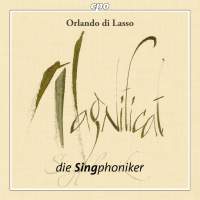Texte paru dans: / Appeared in: |
|
|
Outil de traduction ~ (Très approximatif) |
|
|
Reviewer: J.
F. Weber Among the works of Orlandus Lassus (c. 1532–1594) that were published posthumously by his son Rudolph was a 1619 volume of 100 settings of the Magnificat, the canticle at Vespers that was such an important polyphonic addition to the liturgy, especially at the Munich court. In many cases Lassus used a pre-existing work as the cantus firmus of his setting. A glance at the titles in the headnote will show that the ensemble has recorded the six original pieces to introduce the six Magnificats based on them. This Magnificat setting on “Praeter rerum seriem” was previously recorded in Walter Testolin’s collection (Fanfare 31:2) and in an older Bruno Turner collection on DHM (CD in 14:1). It was also recorded (adding the Josquin motet) in Harry Christophers’s program titled The Earth Resounds (35:6), along with the 10-voice setting on his motet Aurora lucis rutilat. In addition to the six on this CD, we have heard Magnificat settings on Tant vous allés doulx in volume 2 of the musical biography (38:2) and on Las je n’iray in volume 3 (also 38:2); on Quant’ in mille anni il ciel in Stephen Rice’s collection (35:3); on O che vezzosa aurora in Andrew Nethsingha’s collection (35:1); and on Ecco ch’io lasso il core in Detlef Bratschke’s collection (15:4). Lassus also composed five sets of Magnificats for four, five, six, or eight voices (using all eight chant tones), but only a few single items have been reviewed here (one was on that Nethsingha program). Hence this disc adds five recorded premieres to a paltry selection of about a dozen of the 100 works that have been recorded (none before 1970). If one wonders why the duplication of one setting is included––indeed of a work already recorded four times (including one by the King’s Singers that I don’t have)––Jerome Roche (devoting barely a page to the genre in his slender volume on Lassus in the Oxford Studies) called it “one of the most impressive and dignified of the parody Magnificats.” It is based on the Christmas chant Praeter rerum seriem in the Dominican rite, a chant that has been recorded just once to my knowledge. The other five works on this disc, all based on Italian secular models and dating from the early 1580s, were “a radically new departure in Continental Magnificat settings,” as he writes. All of these are alternatim settings, the odd verses in the tone of the chant mode, the even verses in polyphony. The composers of the source pieces range from famous to obscure. Josquin des Prez’s motet has been recorded 15 times and Philippe Verdelot’s madrigal has been recorded several times, as has Cipriano de Rore’s. Passing over Jacquet van Berchem and Claudin de Sermisy, one man requires some comment: Anselmo de Reulx is a new name in the Fanfare Archive. He is shown here to have flourished between 1524 and 1557, so I would guess that his birthdate fell around the turn of the century. The rather extensive notes in the booklet say not a word about him or any of these composers, but Reulx is known to have come from Hainaut (Reulx is a place name there). He served at the Spanish court of Charles V in 1524, then worked in Italy composing madrigals; the first book was published in 1543, the last in 1546. It seems quite certain that this two-and-a-half minute madrigal from the 1543 publication is his very first appearance on disc.
This disc is an impressive
addition to the Lassus shelf, for the motets provide an element of contrast
and variation to the six settings of a single text. The performances by six
unaccompanied men’s voices are ideal in my view. In revisiting previous
releases, it was curious to find two annotators who agreed that the
composer’s Magnificats are “mostly still in manuscript,” ignoring the 1619
edition. For the other kind of Lassus Magnificat, the groups of settings in
all the modes, I’d like to see a CD of the eight settings for eight voices.
Two of them have already been recorded (those in the fourth and seventh
modes), but these double-choir works would offer stunning sound on CD. | |
|
|
|
|
Cliquez l'un ou l'autre
bouton pour découvrir bien d'autres critiques de CD |
|




